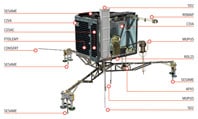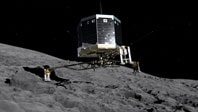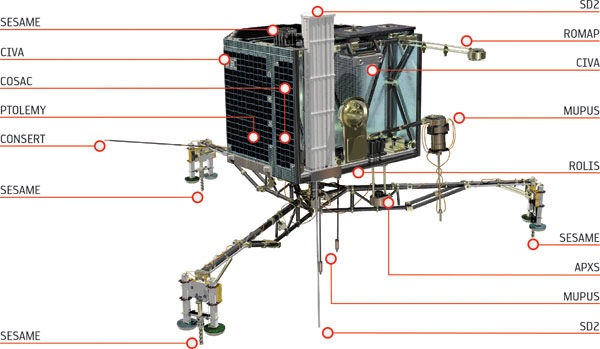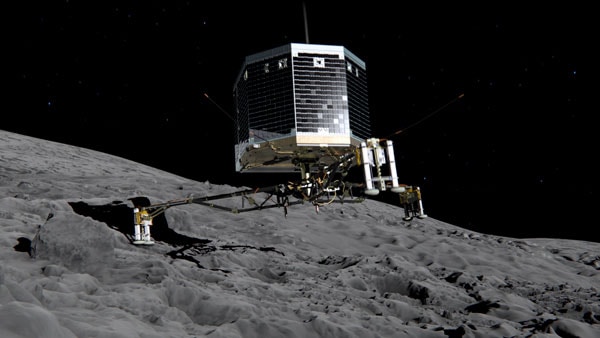Access Agilent eNewsletter February 2015
>> Update My Profile | Subscribe to Access Agilent | Article Directory

GC columns travel to space for comet rendezvous
By Norbert Reuter
Agilent Channels Support Organization Manager
and Gary Lee
Agilent GC Columns Product Marketing Manager
Gas chromatography is a powerful analytical tool that moved out of the lab and traveled millions of miles into space as part of the Rosetta mission. The European Space Agency (ESA) initiated this mission in 1999 with the goal to achieve the first-ever landing of a manmade spacecraft on a comet. The comet probe Philae touched down on the surface of comet 67P on November 12, 2014. This probe has begun to take pictures of the comet’s landscape and – with the help of Agilent J&W GC columns – to analyze its chemical composition.
Scientists study comets because they are time capsules comprised of primitive material that remains from the period when the sun and its planets formed. Unparalleled insight into what happens beyond our atmosphere will be made possible by studying the structure, dust and gas of the nucleus, and organic materials associated with this comet.
 Enlarge
Enlarge
Figure 1. Philae instruments include two GCs (COSAC and PTOLEMY) and a total of five Agilent GC columns. These columns enable chromatography in a completely foreign environment.
Reliable Agilent J&W GC columns enable space-age analyses
Gas chromatography (GC) is a vital part of the Rosetta project because it enables the mission to characterize, identify, and quantify volatile compounds – including larger organic molecules – through in situ measurements of surface and subsurface samples. As shown in Figure 1, the Philae lander includes two gas chromatographs (COSAC and PTOLEMY) among its equipment. COSAC consists of eight capillary GC columns, while PTOLEMY is a GC/MS system with three columns.
GC history in the making
These analyses demand reliable equipment that can send back accurate information to scientists on the ground. The instrumentation deployed to the comet must overcome some major challenges. These include the lack of access after launch, the durability required for such a long mission, and the broad range of potential samples.
The Rosetta mission required columns that were comprehensively tested for column bleed, inertness, efficiency, and consistent reproducibility. Optimal peak shape symmetry with low-level response contributes greatly to the reliability and efficiency of the instrumentation. The systems must deliver accurate results to the analysts on the ground so that ESA researchers are assured that the information they receive is dependable.
Robust, efficient columns
Five Agilent J&W GC columns are used within the Philae lander. Each offers a variety of features that enable them to meet these challenges.
The Agilent J&W CP-PoraPLOT Q column can analyze both polar and nonpolar volatile compounds, giving it broad applicability; this means the lander can achieve all needed measurements with minimal instrumentation. Q-type porous polymer columns with repeatable retention times for long-term stability are especially important to ensure efficiency and reliability throughout the mission.
This focus on efficiency is mirrored in the other GC columns installed in the Philae robotic lander. The Agilent J&W CP-Molsieve 5Å was selected for separation of permanent gasses such as helium, hydrogen, xenon, and argon. With its high efficiency and symmetrical peak shapes, this PLOT column plays an important role in accurately monitoring the composition of these noble gases on the comet surface and in the atmosphere.
The third column, an Agilent J&W CP-Sil 8 CB, has a general-purpose 5% phenyl stationary phase, which provides selectivity and has a temperature limit that has been classically used for a broad range of gas-phase separations, including environmental semivolatile compounds.
The fourth column – an UltiMetal-treated stainless steel column – Agilent J&W CarboBOND was specially designed for this mission. It is able to separate the typical permanent gases we find in our atmosphere, as well as some light hydrocarbons, carbon monoxide, and carbon dioxide.
A fifth GC column, the Agilent J&W CP-Chirasil-Dex CB, incorporates a uniquely bonded chiral phase to separate and identify compounds in racemic mixtures that often occur in nature.
 Enlarge
Enlarge
Figure 2. Philae (shown here) and Rosetta can undertake delicate, sensitive readings in foreign environments, and deliver precisely the data required to draw realiable conclusions.
All the columns that Agilent provided to the Rosetta mission deliver accurate data quickly and require little to no maintenance. This range of column chemistries and selectivities, combined with the high level of quality and reliability, is an essential element reflected throughout the design of Rosetta and Philae (Figure 2).
Accurate results in a challenging environment
The Rosetta mission is the first project of its kind, and is now providing researchers with valuable information that will help them understand the early stages of the earth’s development.
Agilent J&W GC columns have long set a high standard for performance and reliability. It is this standard that makes them so well-suited for this unique project. For more information on Agilent J&W GC columns, please visit our product page. Then explore this American Laboratory article for additional information about the Rosetta mission.
Images reproduced with permission from ESA/ATG Medialab.
>> Update My Profile | Subscribe to Access Agilent | Article Directory

